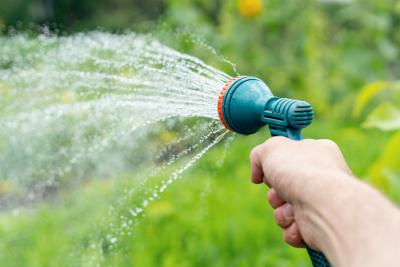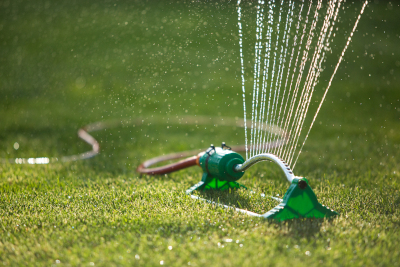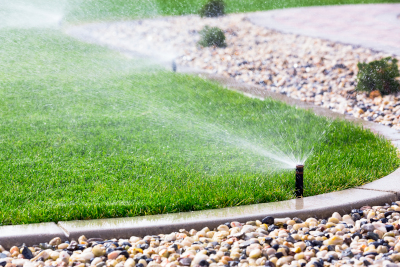
one
two
three


Every landscape needs some supplemental water during the year. In fact, it is estimated that one third of the water used in urban and suburban settings is used to water the landscape. This amounts to about 9 billion gallons of water a day.
Ways to Water

There are three general ways to water your landscape: by hand, with a movable sprinkler, and with a professionally installed irrigation system. Watering by hand lets you direct the water directly to the root zone in the precise quantity that the plant needs. You do not have a lot of evaporation with this method, so it is very cost-efficient. However, it takes lots of time to water everything in the landscape.
Temporary Sprinklers
Hoses with temporary sprinklers on them are another way to water. There are several types.
Stationary sprinklers These deliver a set pattern of water. They are good for putting water on things such as seeds and sod without washing them away. You do need to move them frequently to avoid overwatering.

Oscillating sprinklers typically have a long tube with holes in it that moves back and forth These are good for tall plants as they can throw water high in the air to reach over them. However, since they do throw water high, a lot of the water evaporates or is blown away in the wind.
Impact sprinklers put a stream of water over a set radius on your plants. Most of them have a way to set the radius of the water from 15 degrees to almost 360 degrees. They move when an arm impacts the water stream, so can be very noisy. The water spray is quite strong and can damage small plants and wash away seeds.
Rotary sprinklers typically spray three or more streams of water from the sprinkler. As the water comes out, it spins the sprinkler in a circle. They can cover a large area but are safe for seeds and small plants.
Tractor or Travelling sprinkler This sprinkler moves over a set pattern as it delivers water. It works well for long, flat, areas with turfgrass. It can’t move in soft soil such as a vegetable garden.
All of these sprinklers require time and attention to make sure they do not overwater an area or leave dry spots. There are timers you can get that will make the water come on at a certain time. Still, if you really want to efficiently water your landscape, there is a better way.
Professionally Installed Irrigation System
A professionally installed irrigation system is the most efficient way to water your landscape. Once it is set up, you only have to set your controller each spring to get it started. In the fall, you drain it and turn off the controller, so it doesn’t try to water during the cold temperatures. There are several parts to an irrigation system. These are:
Shutoff valve This allows you to shut off the water to the irrigation system without having to turn off the water to the rest of the property.
Backflow preventer This keeps water from the irrigation system from backing up and contaminating your house water. Some places require the backflow preventer be inspected yearly by a certified backflow inspector.
Main irrigation line This runs from the main building water to the landscape. It allows the rest of the system to have water to run.
Zone lines Landscape irrigation systems are broken down into zones of plants that have similar water needs. This is because the typical residential water pressure cannot run all the sprinklers at once. It is also because different plants have different watering needs. Lawns need different amounts of water more often than trees. Accordingly, these zones typically divide the lawn and the landscape plants.
Valves When the controller tells the valve to open, it lets the water go down the zone line and run the sprinklers. When the timer expires, the valve shuts off, so the water doesn't keep running.

Heads These are the actual sprinklers you see. Sprinkler heads are either rotary or spray (mist) based. Rotors are good for watering large areas of grass. Spray heads usually come in fan shapes that put water out 360 degrees, 180 degrees, or 90 degrees. You can get a variety of other heads to place on the spray sprinkler fixtures. One of them is a rotor that has multiple streams of water flowing out in a circular pattern. These rotors are more water efficient than the bigger rotary heads. Both these types of heads come in pop-up versions that go up when the water is running and go down when it stops. This is safer for people playing in landscape and looks better. They also are easier to mow over.
Drip irrigation This is done with tubing with emitters every so often. It fits under the mulch to deliver water right to the plant’s roots. The problem is when new plants are planted. You have to alter the route the tubing follows to water the new plant. Sometimes the emitters become clogged. This leaves dry plants that do not do as well as the other plants around it. Because the emitters are under the mulch, you probably won’t find the clogged emitter until the plant suffers from lack of water.
Controller The controller is the irrigation system’s brain. It tells valves to open or close at the times it is programed to do so. The controller needs access to power, so it is usually put in the basement. Now you can get WaterSense controllers that either have access to the weather forecast or the soil moisture. The weather controller shuts off when it is supposed to rain. The soil-moisture controller measures the soil moisture to decide when to come on. The typical resident saves 7,600 gallons of water a year with the weather controller and 15,000 gallons a year with the soil moisture model. Some utility companies give rebates for installing one of the two WaterSense controllers.
Professionally Installed Irrigation Systems
Royal Creations Architectural Landscaping can design and install an efficient irrigation system. We proudly use Rainbird parts for the system. Our Blue Crew is very well trained and can install your system so it functions perfectly with no dry spots. We also maintain irrigation systems, so you don’t have to worry about winterizing your system or bringing it online for spring. Contact Royal Creations Architectural Landscaping today to schedule a design consultation.